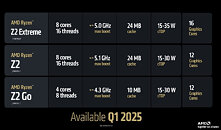
Sony Reportedly Prepping "PlayStation 6 Portable" with "<40 CU" Chipset Design
Sony and Microsoft seem to be involved in the development of handheld gaming consoles, but insiders reckon that respective next-generation offerings will not directly compete with each other. Xbox and ASUS have signalled some sort of collaborative ROG Alloy-esque device; potentially releasing later on in 2025. Whispers of a futuristic PlayStation portable model's chipset design emerged mid-way through March; courtesy of Kepler_L2. The notorious leaker has recent history of reporting inside track knowledge of AMD CPU and GPU architectures/technologies. They alleged that Sony and Team Red's collaborative PS6 APU design project had reached a finalized stage of development, possibly around late 2024/early 2025. Returning to March/April events; Kepler_L2 theorized that a "PS6 Portable" would not be capable of surpassing PlayStation 5 (home console) level performance upon launch in 2028.
The mysterious handheld is said to be powered by a "15 W SoC" manufactured on a non-specific 3 nm node process. Elaborating further, they posit that PlayStation's rumored handheld is capable of running PS5 generation games—bandwidth and power restrictions could reduce resolution and frame rates below that of Sony's current-gen system. Kepler_L2 pictures "PS6 Portable" gaming performance being somewhere in-between Xbox Series S and PlayStation 5 (non-Pro). According to rumors, the handheld's chipset is not related or derived from the PS6 home console's internal setup. Kepler_L2 envisioned a mobile SoC with fewer than 40 compute units (CUs)—several media outlets have added their interpretation of this data point; with a sub-36 count. PlayStation 5's GPU aspect consists of 36 CUs, while the Xbox Series S graphics solution makes do with 20 units. Sony's speculated return to portable territories will be welcomed by owners of older handheld models—namely the Vita and PSP. Famously, these portable products struggled to keep up with competing Nintendo devices.
The mysterious handheld is said to be powered by a "15 W SoC" manufactured on a non-specific 3 nm node process. Elaborating further, they posit that PlayStation's rumored handheld is capable of running PS5 generation games—bandwidth and power restrictions could reduce resolution and frame rates below that of Sony's current-gen system. Kepler_L2 pictures "PS6 Portable" gaming performance being somewhere in-between Xbox Series S and PlayStation 5 (non-Pro). According to rumors, the handheld's chipset is not related or derived from the PS6 home console's internal setup. Kepler_L2 envisioned a mobile SoC with fewer than 40 compute units (CUs)—several media outlets have added their interpretation of this data point; with a sub-36 count. PlayStation 5's GPU aspect consists of 36 CUs, while the Xbox Series S graphics solution makes do with 20 units. Sony's speculated return to portable territories will be welcomed by owners of older handheld models—namely the Vita and PSP. Famously, these portable products struggled to keep up with competing Nintendo devices.

















































































